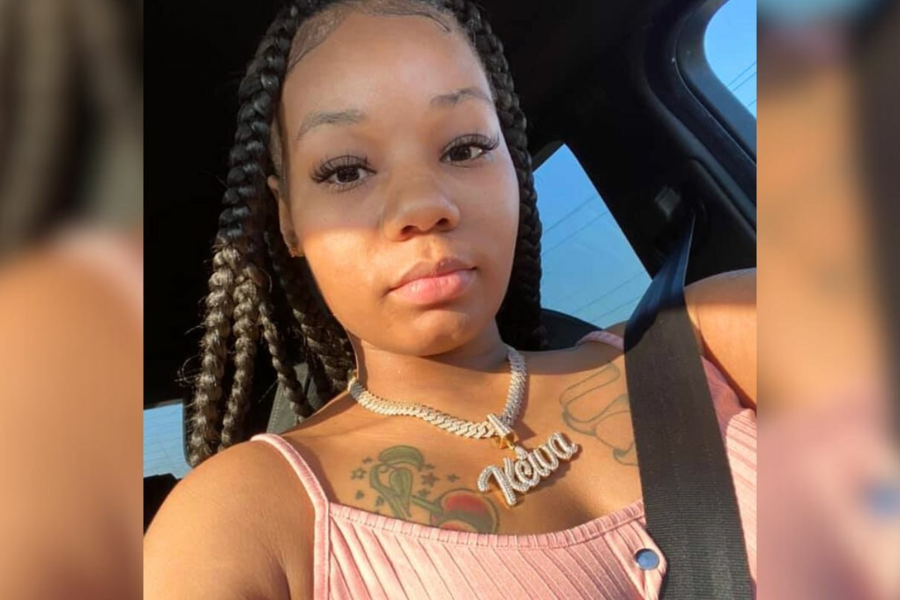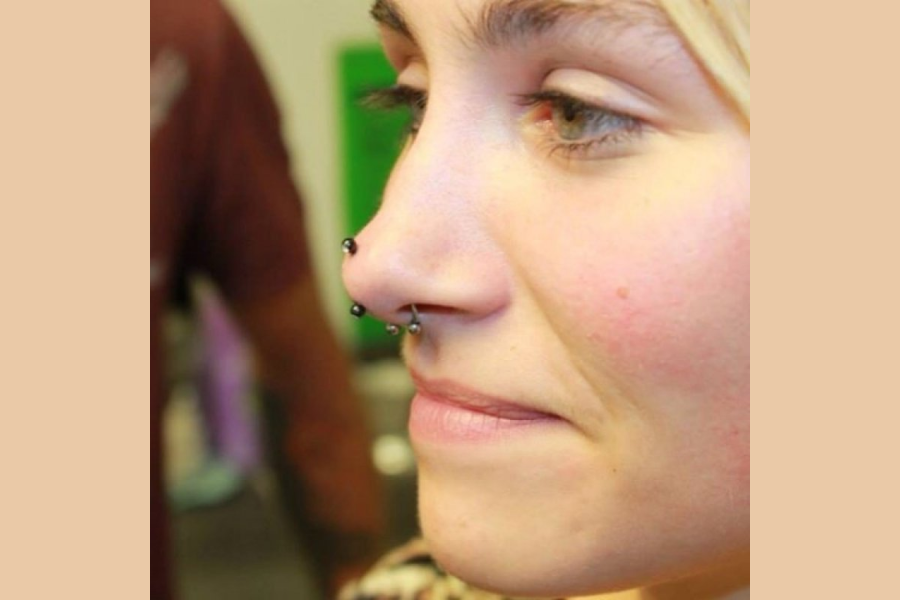
Exploring The World Of Rhino Piercing: A Complete Overview
The art of Rhino Piercing has evolved into a burgeoning phenomenon in the realm of bodily enhancement, captivating the discerning eye of those in pursuit of an unparalleled and avant-garde aesthetic. Prior to embarking on your journey into the realm of Rhino Piercing, it is paramount to grasp the intricacies of the procedure and its multifaceted dimensions. In this exhaustive compendium, we are poised to furnish you with a compendium of insights concerning Rhino Piercing. We shall delve into the myriad species and permutations of Rhino Piercing and prepare you meticulously for the forthcoming procedure. Every step of the process will be meticulously delineated, with a specific emphasis on post-procedural convalescence and potential perils.
Furthermore, we shall deliberate upon the stages of convalescence, methods for mitigating potential discomfort, and the enduring custodial measures requisite for a prosperous and uneventful piercing. Whether you are contemplating the acquisition of a Rhino Piercing or merely inquisitive about this enigmatic form of corporeal enhancement, this guide will endow you with the acumen requisite to render judicious determinations.
What Is Rhino Piercing?
Rhino piercing, also known as the vertical nose tip piercing, is a type of cartilage piercing that goes through the tip of the nose. It’s a unique way to adorn your nose with jewelry.
Conversely, the deep rhino piercing takes things to a more extreme level. This variation starts at the bottom of the nose, travels upwards, and exits higher on the bridge of the nose. It’s a bolder and more adventurous choice for those looking to push the boundaries of body piercing.
Rhino Piercing Variations
Rhino piercing offers a range of captivating variations that enable individuals to express their personal style and personality. Let’s take a closer look at some of the popular rhino piercing options:
The rhino or vertical nose piercing
The rhino, sometimes referred to as the vertical nose piercing, is one of the trendiest nose piercings you might see. It is distinctive in that it originates from the base of your nose, travels through the tip, and ends at the top. This piercing is usually placed in the area just before the major cartilage begins, right between the sections of cartilage in the nose tip. If you gently touch your nose tip, you’ll feel a slight indentation between these cartilage halves, and that’s exactly where the rhino piercing goes through. To adorn this piercing, people often opt for a curved barbell as their jewelry of choice.
The Deep rhino
The deep rhino piercing takes the standard rhino piercing to a more extreme level. It kicks off at the bottom of the nose tip but ventures much higher up the bridge of the nose. Depending on how deep you’d like it, this piercing might be slightly off-center due to the intricate structure of the nasal area. As you ascend on the nose bridge, the cartilage becomes more complex, making it necessary to choose one side for the piercing. There’s a tiny strip of cartilage between the two parts of the nose cartilage that cannot be pierced.
If you prefer a deep rhino piercing that stays in the area before the central cartilage extends, it can be done, but it won’t go as far up the nose. It’s important to note that deep rhino piercing tends to be more painful than the standard rhino piercing due to the additional tissue it passes through. Given its complexity, it’s a piercing that should only be performed by highly skilled piercers. To adorn a deep rhino piercing, a straight barbell is often chosen as the jewelry of choice.
The Septril piercing or half vertical nose
The septril piercing, also referred to as the half-vertical nose piercing, bears some resemblance to the rhino piercing, but they have distinct differences. Some might view them as variations of each other, but they’re not quite the same. The septril shares similarities with a modified septum piercing while incorporating elements of the rhino piercing.
Unlike the rhino piercing, the septril doesn’t exit through the top of the nose. Instead, it features a visible stud on the bottom of the nose tip. The other end of the piercing exits through one nostril, akin to a regular septum piercing. Achieving this piercing involves stretching the septum piercing from 14 gauge to 0 gauge, which is six sizes larger. It’s a challenging process that necessitates several months of gradual stretching to create sufficient space for the septril piercing.
This piercing is quite advanced and isn’t recommended for beginners. It calls for careful planning and the expertise of an experienced piercer to ensure a successful and safe experience.
The Rhino Piercing First Appeared When?
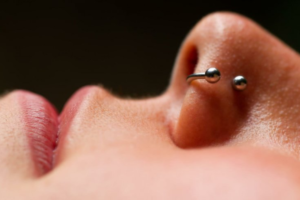
Nose piercings have a rich history, dating back centuries in Middle Eastern, Indian, African, and Australian civilizations. These cultures have long considered nose piercings as a meaningful cultural tradition. Though there isn’t concrete evidence, it’s possible that variations of the rhino piercing, or something similar, might have existed in these societies.
In contrast, the rhino piercing started gaining popularity in the Western world in the early 2000s. Even today, it remains relatively rare compared to other types of piercings.
Preparing For Rhino Piercing
When you’re thinking about getting a rhino piercing, making the right preparations is crucial to ensure a safe and successful experience. Here are four key aspects to keep in mind:
Choosing a Reputable Piercing Studio:
Choosing the right piercing studio is absolutely essential for your safety and the overall quality of the procedure. It’s crucial to seek out studios that maintain a clean and sterile environment, possess the necessary licenses, and have a positive reputation in the piercing community. Reading reviews and asking for recommendations from others can be incredibly helpful in making an informed decision.
Equally vital is the selection of a skilled and experienced piercer. The expertise of the person performing your piercing significantly impacts the outcome and reduces potential complications. Invest time in researching different piercers, closely examine their portfolios, and ensure that they specialize in rhino piercings. It’s crucial to find a specialist who makes you feel comfortable and confident in their abilities.
Understanding the Risks and Potential Complications:
Gaining knowledge about the potential risks and complications tied to rhino piercing is a crucial part of making an informed decision. It’s all about being fully aware before giving your consent. Take the time to research the common risks, like infections, allergic reactions, and migration. This knowledge will help you make decisions and take the required safety precautions. Always put your own safety first.
Preparing Mentally and Physically for the Procedure:
Getting ready for a rhino piercing involves both mental and physical preparation to ensure a smoother experience. It’s critical to mentally anticipate the discomfort of the process and be mindful of its intensity. On the physical front, maintaining good health and preventing infections are crucial for a quick recovery. Following any pre-piercing instructions given by your piercer, such as refraining from alcohol or certain medications, is a must.
By following these guidelines and preparing yourself effectively, you’re setting the stage for a successful and enjoyable rhino piercing experience. Remember, thorough preparation plays a significant role in achieving a satisfying outcome and promoting optimal healing. Your well-being is the top priority.
During The Piercing Process, What Should I Anticipate?
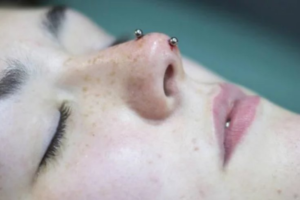
In preparation for embarking on a rhino piercing journey, it becomes paramount to engage in an elaborate discourse with your chosen piercer. Notably, not all practitioners are well-versed in the intricacies of rhino piercings in their various nuances. Thus, it becomes increasingly imperative to ascertain that your selected piercer possesses not only dexterity but also a wealth of experience in this specialized art. This holds particularly true for the more profound rhino piercings, which necessitate an intimate comprehension of the nasal anatomical landscape and precise manipulations to avert any potential harm to the cartilage. It is prudent to establish contact in advance, inquire about the piercer’s comfort level with the intricacies of rhino piercings, and subsequently secure your appointment. To ensure that your rhino piercing journey unfolds flawlessly, it is imperative that you enlist the services of a seasoned, well-regarded, and thoroughly professional piercer. Above all, undertaking a rhino piercing as a do-it-yourself endeavor stands as a resolute “no” – it is imperative to engage the expertise of a seasoned professional.
In tandem with these salient considerations, the procedure for rhino piercings adheres to a semblance of similarity with other piercing practices. Upon your arrival at the piercing establishment, it becomes imperative to conduct a meticulous scrutiny of the hygienic standards. An impeccably sterilized environment is a non-negotiable prerequisite, and the piercer’s workspace ought to exude pristine cleanliness. It is of paramount importance to ensure that the piercing needle is only unwrapped immediately prior to the piercing procedure. Should any uneasiness besiege you, even if you have already assumed the posture on the piercing bed with the marking in place, it remains entirely acceptable to vacate the establishment and seek out an alternative piercer if anything appears awry. Place your trust in your innate instincts.
Upon settling into your chosen position, an aseptic marker will be employed to delineate the entry and exit points of the impending piercing. This represents your final opportunity to effect any requisite adjustments, hence it assumes utmost significance to ensure that it aligns precisely with your preferences. Subsequently, the tangible process of piercing is inaugurated upon your affirmative validation of the placement.
Typically, piercing tongs are the tools of choice to secure the area that is to be pierced. Nonetheless, in the context of a rhino piercing, the idiosyncratic nasal anatomical configuration may not permit this conventional approach. This underscores the indispensable significance of your piercer’s expertise. Subsequently, the piercer will assiduously navigate a hollow piercing needle from the subnasal region to the predetermined egress point. Yes, there will be discomfort. Regardless of the chosen style, rhino piercings entail traversing a substantial expanse of tissue, thus intensifying the agony and prolonging the temporal aspect of the procedure. However, once the needle has completed its traverse, the most arduous portion of the journey is behind you. The selected jewelry will be deftly introduced into the fresh piercing orifice by the accomplished piercer.
Worry About A Rhino-Piercing Scar?
It’s worth noting that rhino piercings can potentially leave a scar behind when you decide to remove the jewelry. It takes time for a nose piercing to heal correctly because it essentially leaves a wound.
Scarring is a complex issue that depends on a number of variables. The final outcome is determined on the size and placement of the piercing, as well as the individual’s particular healing process and genetic propensity for scarring. In some cases, scarring might be more likely for certain individuals. It’s essential to be aware of these potential outcomes when considering a rhino piercing.
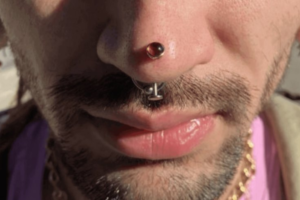
It’s critical to pay great attention to the directions your piercer provides if you’re concerned that scarring may occur when you eventually remove the jewellery from your rhino piercing. These instructions have been specifically created to aid in the piercing’s healing process, which can help lower the likelihood of severe scarring. By faithfully following the recommended aftercare steps and seeking guidance from your piercer as needed, you can enhance the chances of your piercing healing effectively and potentially minimize the chances of noticeable scarring. Your commitment to proper aftercare can make a real difference in the long-term appearance of the piercing site.
Are Rhino Piercings Safe?
When it comes to ensuring the safety of your rhino piercing, much of it boils down to your own diligence and responsible choices. A secure experience begins with finding a licensed and experienced professional piercer who operates in a clean and hygienic environment. This is your first line of defense against potential complications or infections associated with the piercing. It’s a step worth investing time and effort into – researching and selecting a reputable piercer.
Once you’ve found a competent piercer, the next crucial aspect is the proper care of your piercing during the healing process. Following the aftercare instructions provided by your piercer is absolutely vital. Treat the care of your piercing with the utmost seriousness and dedication, almost as if your well-being depended on it – because it does.
It’s important to acknowledge that, like any body piercing, rhino piercings can have their share of potential mishaps or risks. This is precisely why educating yourself about this unique piercing before making a decision is so essential. Take the time to gather information about the process, the expected healing period, potential risks, and the aftercare steps required. Being well-informed empowers you to make educated choices and take the necessary precautions for a safe and successful rhino piercing experience. Your commitment to understanding the process is the first step towards a secure and satisfying outcome.
Rhino Piercing Side Effects
Rhino Piercing, like any other body piercing, carries certain risks and potential negative effects, and some of these are quite common:
Infection: Infections rank among the most frequently encountered risks associated with Rhino Piercing. To minimize this risk, strict adherence to proper aftercare instructions is essential. This involves keeping the piercing area scrupulously clean, using saline solution or the recommended cleaning products, and steering clear of activities that could potentially irritate the piercing or introduce harmful bacteria.
Allergic Reactions: It’s worth noting that some individuals may develop allergic reactions to the jewelry used in Rhino Piercing. If you notice redness, swelling, itching, or a rash around the piercing, it’s a sign of a possible allergic reaction. In such cases, promptly removing the jewelry and consulting your piercer is the right course of action. They can offer guidance on alternative jewelry options or suggest steps to alleviate the allergic reaction. Your safety and comfort should always come first.
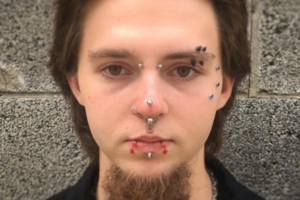
Another potential issue to be mindful of is the risk of damaging the piercing. This can occur due to rough or vigorous activities or if the jewelry gets caught on clothing or other objects. It’s important to handle the area around the piercing with care. Avoid engaging in activities that could potentially pull or tug at the jewelry and be conscious of how you handle and care for the piercing.
To reduce the chances of side effects and complications stemming from Rhino Piercing, selecting a reputable and experienced piercer is paramount. Look for a professional who strictly adheres to sterilization and safety protocols to minimize the risk of infection and other issues. Furthermore, diligently following the aftercare instructions provided by your piercer is essential for promoting proper healing and reducing the likelihood of experiencing any side effects or complications. Your choice of piercer and your commitment to aftercare are key factors in ensuring a safe and successful piercing experience.
Rhino Piercings Are Uncommon
According to TK Garcia, a highly experienced piercer with three decades in the field, rhino piercings are anything but common. In fact, Garcia mentioned having only performed one in their entire career. One reason for this rarity could be the slow healing process associated with rhino piercings. Additionally, they’re generally considered to be quite painful, although it’s worth noting that pain is subjective and can vary from person to person.
The actual procedure for getting a rhino piercing is relatively straightforward. It involves the use of a standard piercing needle and a curved barbell. However, due to the intricate nature of the cartilage at the tip of the nose, precision in positioning and technique is of utmost importance to prevent any damage or unnecessary trauma, as highlighted by TheTrendSpotter. Healing time can range from six to nine months, but Pierce Journal suggests it might take up to a year.
To support the healing process, it’s recommended to rinse the piercing site with a saline solution soak or spray at least twice a day. Alternatively, you can opt for dipping your piercing into a bowl of saline solution, a method preferred by Pierce Journal. Equally vital is the practice of not touching the new piercing with your hands to minimize the risk of introducing bacteria and causing an infection.
While rhino piercings undoubtedly offer a unique way to make a statement, it’s crucial to consider both the potential discomfort involved and the patience required for the healing journey.
Pros And Cons Of Rhino Piercing

A rhino piercing is one that traverses the nose bridge, and it’s undoubtedly a unique choice. Like any piercing, it comes with its own set of advantages and disadvantages.
Pros:
- Rhino piercings are eye-catching and distinctive.
- They can add character or edge to your ensemble.
- They require little upkeep.
- They are fantastic means of self-expression.
Cons:
- A rhino piercing hurts.
- It can take up to a year for healing.
- With these, infection is more likely.
- They’re difficult to conceal, which can be a problem if your career or lifestyle demands a conservative appearance.
For people seeking a unique and personal expression, rhino piercings are safe and elegant. It’s crucial to examine the advantages and downsides before buying one.
If you’re thinking about getting a rhino piercing, it’s essential to take into account these additional factors:
- Choose a reputable piercer with experience performing this type of piercing.
- Guidelines for aftercare should be followed.
- Recover gradually.
- Visit a doctor if you believe you have an infection.
With proper care and attention, rhino piercings can not only be visually appealing but also have the potential to endure for a long time.
What Is The Healing Time For A Rhino Piercing?
The healing journey for a Rhino Piercing typically spans a longer duration, usually around 6 to 9 months. This is notably slower compared to many other piercings. The extended healing timeline is due to the specific placement of the piercing and the complex nature of the underlying tissue.
It’s important to keep in mind that individual healing times can be quite variable. Factors like your body’s unique response to the piercing, your overall health, and how faithfully you adhere to aftercare instructions all play a role in influencing the healing process. Your personal healing experience may be quicker or take more time than the average timeframe we’ve mentioned.
To minimize the risk of complications and ensure a comfortable healing journey, it’s absolutely crucial to adhere to the proper aftercare instructions. These guidelines might involve regular cleaning of the piercing site with a saline solution or specific cleaning methods recommended by your piercer. By following these instructions diligently, you can contribute to the proper healing of the piercing and potentially reduce any discomfort during this phase. Your commitment to aftercare is a vital part of the healing process.
How Can A Rhino Pierce Heal More Quickly?
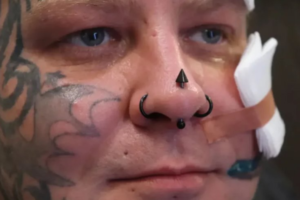
Just like any other body piercing, taking good care of your rhino piercing is essential for a smooth healing process. Here are some practical tips to help your rhino piercing heal more quickly:
Follow a Strict Aftercare Routine:
To speed up the healing process, it’s crucial to stick to a diligent aftercare routine. Cleanse your piercing twice a day using saline solution or a mild, non-alcoholic cleanser recommended by your piercer. Be mindful to avoid touching the piercing with unwashed hands and resist the urge to twist or turn the jewelry, as this can lead to irritation. Your commitment to this routine is key to a quicker healing process.
Avoid Disruptive Activities:
Activities that can disrupt the healing process should be avoided, as they might prolong recovery time. Steer clear of swimming in pools, hot tubs, or natural bodies of water until your piercing has completely healed. It’s also a good idea to limit contact with cosmetics, hair products, and excessive sweat, as these substances can introduce bacteria and potentially cause irritation to the piercing. Being cautious in this way will contribute to a smoother healing experience.
Maintain Good Hygiene:
Ensuring the cleanliness of the piercing area is of utmost importance for expediting the healing process. It’s essential to refrain from unnecessary touching of the piercing. When it comes to cleaning, opt for a clean cotton swab or a sterile saline solution to gently clear away any crust or debris. These simple steps are vital for a faster and smoother healing experience. Your diligence in maintaining cleanliness will make a difference.
Opt for Proper Jewelry:
The choice of jewelry plays a critical role in the healing process. Opting for materials like titanium, surgical steel, or high-quality gold can make a substantial difference. These materials are less likely to trigger allergic reactions or complications. Furthermore, it’s important to select jewelry that fits comfortably and doesn’t exert undue pressure on the piercing. Making the right jewelry choices can significantly contribute to a smoother healing experience. Your selection of jewelry should prioritize both comfort and safety.
Eat a Balanced Diet and Stay Hydrated:
In addition to being great for your general health, eating a balanced diet and drinking plenty of water can also hasten the healing process. The mending of tissues is greatly aided by vitamins A and C, zinc, and omega-3 fatty acids. Moreover, ample water intake keeps your skin in good condition. So, remember that what you eat and drink can contribute to your healing journey and overall health.
Minimize Disruptions and Trauma:
Steer clear of any unnecessary handling, tugging, or sleeping on your piercing. Minimizing any disturbances or potential trauma to the area is vital to prevent irritation, inflammation, or unintentional injury. Treat your healing piercing with the care and respect it needs to ensure a smooth recovery. Your thoughtful precautions can make a real difference in the healing process.
Patience and Time:
Finally, keep in mind that healing times are unique to each individual. Patience is key, so allow your body the time it needs to heal properly. Rushing the process or changing jewelry too soon can potentially result in complications and extend the healing period.
By embracing these suggestions and maintaining diligent care, you can actively support a speedier healing process for your rhino piercing. However, if you encounter any unusual symptoms or concerns during the healing phase, don’t hesitate to seek guidance and assistance from your piercer or a healthcare professional. Your well-being is paramount, and their expertise can be invaluable in ensuring a successful healing journey.
How To Care For A Rhino Piercing
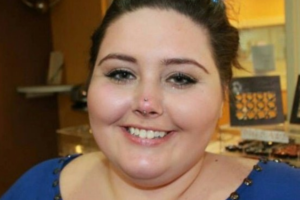
Once you’ve acquired a rhino piercing, it’s essential to adhere to specific aftercare guidelines. Here are five practical tips for taking care of your new piercing:
- Before you tend to your piercing, be sure to wash your hands thoroughly with soap. Afterward, use a saline solution along with a clean cotton cloth or a Q-tip to delicately cleanse the piercing two to three times a day. Your piercing’s cleanliness is paramount in the healing process.
- To care for your piercing, consider soaking it in warm saline solution twice a day for about 5 minutes. This routine not only aids in keeping the piercing clean but also supports the healing process. Taking these steps can make a notable difference in your piercing’s well-being.
- It’s best to gently pat the area dry with a paper towel after washing or bathing your piercing. It is advised to avoid using regular towels on your piercing since they may contain bacteria that could cause an infection. Ensuring cleanliness is a crucial step in your aftercare routine.
- Resist the urge to touch your piercing, even though it can be quite tempting, especially when it’s on your nose. Any movement of the jewelry or touching the area can disrupt the healing tissue and potentially hinder the overall healing process. Exercising patience and discipline in this regard is crucial for a successful healing journey.
- It’s important to give your piercing some post-shower attention. Make sure to thoroughly clean the piercing site to remove any soap residue that could potentially irritate it. This extra care can go a long way in maintaining your piercing’s well-being.
With these care tips in your arsenal, you can actively contribute to the proper healing of your rhino piercing while reducing the chances of complications or infections. Your commitment to aftercare is instrumental in ensuring a successful piercing experience.
Rhino Piercing Aftercare: Do’s And Don’ts
Ensuring the successful healing of your rhino piercing hinges on proper aftercare. To help you steer clear of complications and ensure a smooth recovery, here are some important dos and don’ts to keep in mind:
Do’s
1Cleanse the Piercing Regularly:
Stick to a consistent cleaning routine to maintain the cleanliness of the piercing site and keep it free from harmful bacteria. Your best bet is to employ a saline solution or a mild, non-alcoholic cleanser, as advised by your piercer. This gentle cleaning regimen, done twice a day, is a key step in averting infection and facilitating the healing process. Your dedication to this routine is a valuable aspect of proper aftercare.
Practice Good Hygiene:
Practicing good hygiene throughout the healing phase is paramount. Always ensure that you thoroughly wash your hands before coming into contact with the piercing area or handling the jewelry. This simple precaution goes a long way in reducing the chances of introducing harmful bacteria and potentially causing an infection. Your commitment to cleanliness is a fundamental aspect of proper aftercare.
Be Mindful of Sleeping Positions:
It’s a good idea to steer clear of sleeping directly on your piercing, as this can lead to irritation and impede the healing process. Instead, consider sleeping on your back or find a comfortable position that doesn’t exert pressure on the piercing. Making this adjustment can go a long way in ensuring a smoother healing journey. Your comfort during sleep matters for your piercing’s well-being.
Follow Your Piercer’s Advice:
It’s crucial to pay close attention to the guidance given by your piercer and follow their advice diligently. They will offer you tailored instructions designed for your specific piercing to maximize the chances of a successful healing process. If any questions or concerns arise, don’t hesitate to reach out and contact them. Your piercer’s expertise is an invaluable resource in your piercing journey.
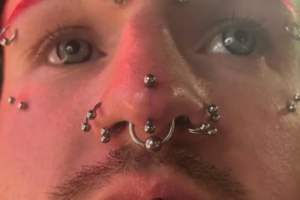
Don’ts
Don’t Touch the Piercing with Dirty Hands:
Steer clear of unnecessary contact with your piercing, particularly with unwashed hands. Touching the piercing with dirty hands can introduce harmful bacteria, potentially causing infections and slowing down the healing process. Only handle the piercing when it’s necessary, and always ensure your hands are clean before doing so. Your attention to cleanliness is a key factor in your piercing’s well-being.
Avoid Changing the Jewelry Prematurely:
It’s important to resist the urge to swap out the jewelry before your piercing has completely healed. Premature jewelry changes can slow down the healing process and heighten the risk of infection. Instead, trust your piercer’s advice regarding when it’s safe to transition to new jewelry. Patience in this matter is a key element in ensuring a successful healing journey for your piercing.
Steer Clear of Harsh Products or Chemicals:
Steer clear of using strong cleaning products, alcohol-based solutions, or hydrogen peroxide on your piercing. These substances can be overly drying or irritating, which could impede the healing process. Stick to the gentle, saline-based solutions suggested by your piercer for the best results. Your commitment to using the right solutions is essential for the well-being of your piercing.
Don’t Remove the Jewelry Too Early:
Unless you’ve received guidance from a professional, refrain from taking out the jewelry before your piercing has fully healed. Removing it too early can result in the piercing closing up and possibly requiring a new procedure.
By following these dos and don’ts, you can actively support the healing and success of your rhino piercing. Always keep in mind that consistent and attentive aftercare is a crucial factor in determining the overall outcome of your piercing. Should you encounter any concerns or unusual symptoms, don’t hesitate to reach out to your piercer or seek medical advice for expert guidance. Your health and the success of your piercing are of paramount importance.
Rhino Piercing Jewelry
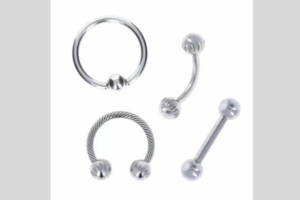
When it comes to rhino piercing jewelry, it’s not just about style; it’s also about promoting healing and ensuring comfort. Let’s explore some factors and options to keep in mind when it comes to rhino piercing jewelry:
Material Selection:
Choosing the right material for your rhino piercing jewelry is a critical decision, aimed at reducing the likelihood of allergic reactions and encouraging the healing process. Among the common materials to consider are:
Titanium: This is a top pick, known for its hypoallergenic properties and lightweight feel. Titanium is a superb option, particularly for individuals with sensitive skin or nickel allergies.
Surgical Steel: Surgical steel is another popular choice, offering a combination of durability, affordability, and compatibility with most skin types. Just make sure it’s implant-grade steel for the best results.
High-Quality Gold: 14k or 18k gold adds elegance and luxury to your piercing. For best results, choose solid gold over gold-plated.
Styles and Designs:
When it comes to rhino piercing jewelry, the choices are abundant, with a variety of styles and designs to suit your preferences. Here are some popular options to consider:
2.1. Captive Bead Rings (CBRs): These are circular rings with a removable bead that securely fits within the ring. They are versatile and make it easy to insert and remove.
2.2. Straight Barbells: Straight barbells come with threaded balls on both ends, offering a clean and minimalist appearance.
2.3. Curved Barbells: These barbells have a gentle curve, designed to complement the shape of the piercing. They not only enhance the aesthetic appeal but also provide a comfortable fit.
2.4. Circular Barbells: Circular barbells resemble a horseshoe shape, adorned with threaded balls or decorative ends. They bring a distinctive and stylish flair to your rhino piercing.
Size and Fit:
Your comfort and the healing process are greatly influenced by the size and fit of your jewelry. Your piercer will play a crucial role in assessing the right gauge (thickness) and length of the jewelry, taking into account your unique anatomy and the initial swelling. It’s important to steer clear of jewelry that’s either too tight or too loose, as it can lead to complications. Finding the right fit is key for your overall piercing experience.
Customization and Upgrades:
As your piercing progresses through the healing stages, you’ll likely have the opportunity to personalize or upgrade your jewelry. Once the initial healing period has passed, you can delve into an array of decorative ends, gemstones, or charms that can infuse a personal touch and reflect your individual style.
It’s worth emphasizing that consulting with a professional piercer is a must when it comes to selecting the ideal jewelry for your rhino piercing. They can offer valuable insights based on your preferences, unique anatomy, and how your piercing is healing. Always prioritize aspects like comfort, quality, and compatibility when making choices about rhino piercing jewelry. This approach ensures that your experience is not only successful but also thoroughly enjoyable.
Other Types Of Nose Nose Piercing
Beyond rhino piercings, there’s a world of other nose piercing options, each with its unique style and self-expression. Let’s dive into some popular alternatives:
Nostril Piercing:
One of the most common nose piercings is the nostril piercing, which involves piercing the side of the nose. This style allows for a wide range of jewelry options, from studs and hoops to rings, providing plenty of versatility to suit your personal taste.
Septum Piercing:
Septum piercing is all about piercing the delicate tissue inside the nose. It pairs beautifully with horseshoe rings or clickers. The beauty of this piercing lies in its versatility – you can easily hide it or proudly display it, depending on your mood and style.
High Nostril Piercing:
The high nostril piercing takes a bold stance, sitting higher on the nose, closer to the bridge. It offers a distinctive and edgy appearance, perfectly complemented by studs or dainty hoops to complete your unique style.
Nasallang Piercing:
The nasallang piercing is not for the faint of heart – it’s an advanced piercing that goes through both nostrils and the septum simultaneously. This daring choice demands a skilled and experienced piercer to execute. The result is a bold and striking look that truly makes a statement. Typically, barbells or straight barbells are chosen to adorn this piercing.
Bridge Piercing:
The bridge piercing is a distinctive choice, as it’s positioned horizontally through the bridge of the nose, usually nestled between the eyebrows. This piercing creates an intriguing bridge-like effect, making it a unique style statement. It’s commonly embellished with straight barbells or surface bars, adding to its eye-catching appeal.
Double Nostril Piercing:
The double nostril piercing is a double dose of style, featuring two separate piercings on one side of the nose, often placed parallel to each other. With this piercing, you have the freedom to get creative with your jewelry choices, whether you prefer studs, hoops, or rings in each piercing.
Every nose piercing is a unique expression of individuality. Professional piercers are your best allies in selecting the nose piercing that suits your anatomy and style. Remember to put aftercare at the top of your list to ensure a smooth healing process and minimize any potential issues. Your unique style deserves the best care!
Rhino Piercing And Personal Style
Rhino piercing is more than just a body modification – it’s a form of self-expression that allows you to showcase your individual style and enhance your beauty. Let’s explore how rhino piercing can be a captivating addition to your personal flair:
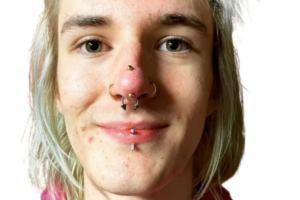
Rhino piercing, renowned for its audacious and avant-garde aesthetics, possesses an innate ability to command attention and singularly distinguish your countenance. It unquestionably introduces an element of sharpness and distinctiveness to your overall visage.
What truly captivates one’s intrigue regarding rhino piercing is the vast array of embellishments at one’s disposal. Whether your inclination veers towards a modest stud or a more intricate hoop, you shall encounter selections that seamlessly resonate with your individualistic panache. The array is nigh infinite, spanning the gamut from elementary and unembellished motifs to complex and opulent configurations.
Yet, rhino piercing transcends mere adornment – it serves as a conduit for self-expression. Your persona, passions, and the mosaic of cultures that influence you, all find a voice through the ornaments you elect to adorn yourself with. From exquisite gemstones to enchanting talismans, from unique silhouettes to symbolic iconography, you wield the creative autonomy to curate an anthology of embellishments that genuinely mirror your essence.
Furthermore, the allure of rhino piercing extends its hand in graceful concord with your pre-existing facial piercings, whether it be a septum, nostril, or any permutation of piercings. It possesses the ability to harmonize and elevate your facial features, introducing an added dimension of allure to your overall facade.
One of the most conspicuous merits of rhino piercing lies in its versatility. It seamlessly integrates with a multiplicity of sartorial genres and voguish trends. Whether your proclivity leans towards punk, bohemian, or a more conventional and refined aesthetic, rhino piercing imparts a modicum of innovation and intrigue to any vogue.
In your odyssey of personal expression, wherein you unfurl the tapestry of your individuality, rhino piercing emerges as a potent instrument. It allows you to distinguish yourself and unveil your inner essence. To ensure the precise placement and diligent upkeep of your rhino piercing, it is judicious to seek counsel from a seasoned and proficient piercer. They shall serve as your compass in navigating this striking avenue of self-expression.
People Also Ask (FAQs)
Here Are Some (FAQs):
Q: Does getting a rhino piercing hurt?
A: Due to its location on the nasal bridge, rhino piercing is usually more painful than nostril or septum piercings. The pain is usually short-lived. Your piercer may apply a numbing chemical or provide you with aftercare instructions to reduce pain.
Q: How long does it take for a rhino piercing to heal?
A: A rhino piercing takes 6 to 12 months to recover on average. Following aftercare recommendations and practicing basic cleanliness can help you recuperate and avoid illness.
Q: Can I change the jewelry in my rhino piercing during the healing process?
A: It is generally recommended to avoid changing the jewelry in your rhino piercing until it has fully healed. Too fast jewelry changes might delay recovery, increase infection risk, and disturb the healing process. Consult with your piercer for guidance on when it is safe to change the jewelry.
Q: What are the risks associated with rhino piercing?
A: Like any body piercing, rhino piercing has hazards. Infection, hemorrhage, allergic responses to jewelry, scarring, and piercing migration or rejection are possible. Choose a reputable piercing studio, follow aftercare instructions, and seek professional help if you develop an infection or complications to reduce these risks.
Q: Can I remove a rhino piercing if I change my mind?
A: Yes, a rhino piercing can be removed if you decide you no longer want it. However, removing the jewelry too early in the healing phase can close the piercing, which may require re-piercing.
Q: Can I hide a rhino piercing for work or other occasions?
A: Rhino piercing is quite visible due to its placement on the bridge of the nose. While it may be difficult to completely hide, you can opt for jewelry options that are less conspicuous, such as small and discreet studs or retainers. It’s best to check with your employer or consider the dress code requirements for specific occasions to ensure compliance.
Final Words
Rhino piercing is undeniably intriguing. Throughout our discussion, we’ve explored its variations, the vital aspects of aftercare, the diverse world of jewelry, and how it enhances personal style. It’s a piercing that not only allows for self-expression but also enhances one’s aesthetic appeal.
However, embarking on the journey of a safe and successful rhino piercing requires careful consideration. It all begins with the selection of a reputable studio and an experienced piercer who can make your vision a reality. Being aware of the potential risks associated with rhino piercing is crucial in making informed decisions and taking necessary precautions.
But the path to a smooth and successful rhino piercing doesn’t end there. It involves both mental and physical preparation, ensuring you’re ready for the procedure and the healing process that follows. We’ve provided a comprehensive list of do’s and don’ts to facilitate a faster and complication-free healing experience.
And while rhino piercing is a standout choice, we’ve also delved into other nose piercing options, showcasing how they, too, enable individuals to express their unique style. The world of nose piercings is as diverse as it is fascinating.
Choosing the right jewelry is not just about aesthetics but also about comfort and healing. It’s a decision that should be tailored to your personal preferences, anatomy, and the healing journey ahead.
In the end, rhino piercing serves as a means of self-expression and a captivating transformation. It adds beauty and individuality to your life when done with professional guidance and a touch of personal style. It’s a journey worth taking for those who wish to express themselves and stand out with flair.

